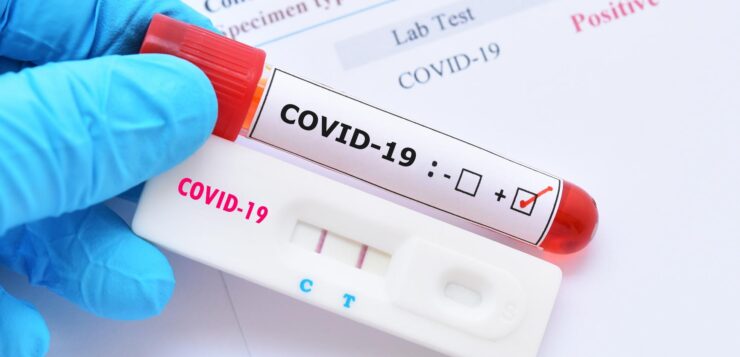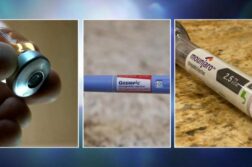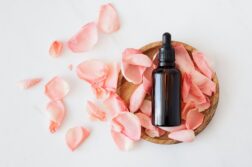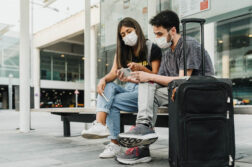Which Covid Test Should I Get? When Should I Test? What If I Can’t Find One? Answers About Testing and Omicron.
Facing long lines and shortages of home test kits during the latest surge, people are searching for answers about Covid tests.
By Tara Parker-Pope, Dani Blum and Nicole Stock
Testing is essential to stopping the spread of Omicron. But nearly two years into the pandemic, many people are still confused about the best way to get tested for Covid-19, or frustrated that they can’t find a test.
Stores have run out of home tests, and long lines at testing centers have made it difficult for people to find out quickly if they are infected. We asked public health experts for answers to some common questions about coronavirus testing during the Omicron surge. Here’s what they had to say.
Holiday Testing
Is one type of test better than the other?
Virus tests are categorized based on what they look for: molecular tests, which look for the virus’s genetic material, and antigen tests that look for viral proteins. But comparing rapid antigen tests and lab tests (also known as P.C.R. tests) is sort of like comparing an X-ray to an M.R.I. scan. Both tests are reliable, serve unique purposes and can be useful at different times. The advantage of an X-ray is that it’s cheap, fast and pretty good at spotting obvious problems. An M.R.I. takes much longer and costs a lot more but gives you a more precise look at what’s going on in the body.
The advantage of rapid antigen tests, whether they are taken at home or at a testing center, is that they are fast, relatively cheap and are highly reliable for telling you right now if you’re spreading the virus. A P.C.R. test is more sensitive and will identify an infection sooner, but it takes more time to get the result. Both tests are useful, but with a fast-spreading variant like Omicron, a rapid test can prompt someone to isolate a few days sooner, sparing others from your germs.
When is the best time to take a rapid home test before seeing family for the holidays?
Home tests can tell you whether you are infected with coronavirus right now. So you should test as close as possible to the time of the gathering, preferably about an hour or two before everyone gets together, advises Dr. Ashish K. Jha, dean of the Brown University School of Public Health.
Dr. Michael Mina, a former Harvard epidemiologist who is now the chief science officer for eMed, a company that distributes at-home tests, advises an even tighter testing window. He suggests you take the test in your car just 15 minutes before the event, if that’s practical.
While it’s important to test on the same day of the event, if you have extra time or extra tests, two tests over a few days are better than one. A few days before your party, try getting a lab test or take a rapid test, and then make sure you test again on the day of the event.
A negative test does not lower your risk to zero. But taking a test does significantly reduce the risk that someone at your gathering will transmit the virus. “A test will not protect you from getting infected,” said Dr. Mina. “A test will protect you from infecting other people.”
If you’re flying or taking a train, you should test the day you travel to make sure you’re not infecting your fellow passengers. Once you arrive, you should test in two or three days to make sure you didn’t pick up the virus during your travels.
What if I can’t find home tests before the holidays?
The most important precaution is that everyone at the party who is eligible be fully vaccinated and have a booster shot. But since even vaccinated people can spread Omicron, rapid testing a few hours before an event adds another layer of protection and can prevent an infected person from unknowingly spreading the virus at the gathering.
But if you can’t find rapid home tests, everyone should try to get a lab test as close as possible to the event, timing it so you get the results back before you see everyone. “Any test is better than no test,” said Mara Aspinall, an expert in biomedical diagnostics at Arizona State University who is also on the board of OraSure, which makes rapid Covid tests.

Limit other activities and try to isolate as you wait for the lab results so you don’t get infected in the interim.
If everyone at the party can’t get tested, then you’ll need to assess the risk. If all the partygoers are relatively young and healthy, and everyone has been vaccinated and boosted, the risk of gathering is relatively low.
But if a vulnerable person — someone very old or who has significant health risks — will be at the party, you may decide to scale it back or cancel if everyone can’t be tested. If you decide to gather without testing, consider asking everyone to wear masks, and focus on ventilation by opening windows or getting a HEPA air cleaner. If you’re in a warm area, try taking activities outside.
“If you can’t get tests, you have to decide how much risk you’re willing to take,” said Dr. Robert Wachter, professor and chairman of the department of medicine at the University of California, San Francisco. “Would I still get together if I couldn’t find a test? In a relatively low risk situation, with everyone boosted and vaccinated and everyone feels fine, I probably would. If someone is at high risk and I couldn’t get a test, I think I’d be inclined to have people wear masks and keep the windows open. I’d do the best I could to keep everyone as safe as possible.”
Timing of Tests
When is the best time to test if I was exposed to an infected person?
Omicron moves fast, and many public health experts say people with potential exposures to the virus should test sooner than advised for previous variants. The current guidance from the Centers for Disease Control and Prevention says vaccinated people don’t have to quarantine if they have had close contact with someone who has Covid-19, but that they should get tested five days later. Testing experts, however, say that’s probably not soon enough for Omicron.
A recent outbreak of Omicron Covid infections in Norway after a holiday office party in November gives us clues about the best time to test based on how quickly an Omicron exposure can “convert” to an infection, said Dr. Wachter. The party was held in a restaurant on a Friday, and everyone was vaccinated. Of 80 confirmed and suspected cases, nearly 75 percent were detected on the Sunday, Monday and Tuesday after the party. That suggests that the best times to test are on days 2, 3 and 4 after exposure.
So if you think you’ve been exposed to an infected person, or you’ve been traveling through airports and are worried that you picked up the virus, the best time to start testing is probably on day 2 and 3 after the event. If you can, test daily or every other day at least through day 6. And if you know you were exposed to an infected person, it’s a good idea to limit your contacts and mask up around others for about a week after the exposure.
Is it possible to test too early?
Yes. Don’t test immediately after an exposure or high-risk gathering and assume you are in the clear, since it can take a few days for the virus to reach detectable levels. “Doing it too soon is like a pregnancy test,” said Dr. Panagis Galiatsatos, a pulmonary and critical care medicine physician at Johns Hopkins Medicine. “If you test too soon, it means nothing.”
The advice changes if you already are experiencing Covid symptoms. In that case, you should get tested right away. Try taking a rapid test on the day symptoms start, and if that’s negative, take another test a few days later.
When should you retest if your first test is negative?
If your first test is negative after you’ve had a known exposure (or attended a high-risk gathering), you should test again two or three days later, taking precautions in the interim.
I have symptoms but tested negative on a rapid test. Am I in the clear?
No. If you start to feel Covid symptoms, especially if you live in an area with high case numbers, you should assume that you have the virus, at least until you’ve tested negative at least twice over a few days. Early symptoms in a vaccinated person may be a sign that the body is fighting the virus, and it’s possible the viral load isn’t yet high enough to turn a rapid test positive. “Take symptoms seriously,” said Dr. Mina. “Our bodies are giving us an early warning signal.”
If you have symptoms and your rapid home test is negative, it’s still a good idea to try getting a lab-based P.C.R. test, which may find the virus sooner. If that test is also negative, it’s unlikely you have Covid. But if you have any respiratory symptoms, you still should stay home. In addition to Covid, you can also ask to be tested for two other potentially serious viral illnesses — influenza (the flu) and respiratory syncytial virus (RSV) — which are also circulating.
Understanding Test Results
What does an “indeterminate” result mean?
While it’s unclear how often it happens, some people who get tested for Covid at a hospital or testing center receive an “indeterminate” test result. If this happens to you, you should not assume you are negative. You should retake the test, at a different testing site if possible.
Indeterminate results happen for a variety reasons. Sometimes the sample itself is inadequate for testing. In some cases, a mistake in processing or a machine calibration issue can lead to an indeterminate result. And sometimes it happens because the patient’s viral load is so low, it doesn’t create a true positive result.
Should I retest if I got a positive result on a home test?
If your rapid test is positive, you should assume that you have Covid. If you have reason to doubt the result, you can take a second test. False positives aren’t common, but they can happen. Most experts say they would isolate after a positive rapid test, but they would also get a confirmatory test from a lab. Getting the confirming lab test means your positive result will be documented in your medical records, which could speed things along if a patient needs additional treatments or develops Covid-related health issues in the future.

My lab test result is different than my rapid test. Which test is right?
It’s possible to test negative on a rapid test and test positive on a P.C.R. test. Both results may be correct, even if they disagree. The reason is that the tests are looking for different things. Rapid tests look for antigens indicating you’re infectious. A negative test indicates you’re not spreading coronavirus right now. A lab-based P.C.R. test is more sensitive and can tell you sooner if you’ve been infected with coronavirus. It’s possible for a P.C.R. test to detect coronavirus when you’re not infectious.
If you test positive on a rapid antigen test, and later test negative on a P.C.R. test, you probably don’t have Covid, said Dr. Jha. In this case, the rapid test likely was a false positive.
If you have respiratory symptoms and get conflicting test results, it’s worth getting a third lab test a day or two later to break the tie.
“If you’re testing in the context of symptoms, and you have a positive test on either one, then I would take them seriously and consider them positive, and not be reassured by the negative one,” said Dr. Paul Sax, an infectious disease expert at Brigham and Women’s Hospital and professor at Harvard Medical School.
If you’ve received conflicting test results and are not able to get a third test to break the tie, you should still take protective actions to prevent spreading the illness, said Tara Kirk Sell, a senior scholar at the Johns Hopkins Center for Health Security.
Types of Tests
What’s the difference between a rapid antigen test and a lab-based P.C.R. test?
Virus tests all use a sample collected from the nose, throat or mouth that may be sent away to a lab or processed within minutes at home.
An antigen test hunts for pieces of coronavirus proteins. Most rapid home antigen tests work sort of like a pregnancy test — if virus antigens are detected in the sample, a line on a paper test strip turns dark. The tests are highly reliable for telling you if you’re spreading the virus on the day you take the test, but a single test won’t tell you that you definitely don’t have coronavirus. The main advantage of the test is that it’s fast, and can be used to lower the risk of small indoor gatherings.
A laboratory molecular test, also known as the P.C.R., or polymerase chain reaction, test, uses a technique that looks for bits of the virus’s genetic material — similar to a detective looking for DNA at a crime scene. This test is considered the gold standard of coronavirus testing because of its ability to detect even very small amounts of viral material. A positive result from a P.C.R. test almost certainly means you’re infected with the virus. The downside is that the typical turnaround time is one to three days, and during the current Omicron surge, people seeking tests are waiting in long lines and some centers are running out of tests.
Are nasal swabs better than spit tests?
Some lab tests use a nasopharyngeal swab that is inserted deep (and uncomfortably) into the nasal cavity. Home tests typically rely on a nasal swab that collects a sample with a few easy swishes inside both nostrils. And some tests use a collection method that requires the patient to drool or spit into a test tube. For some people it might take about five minutes to generate enough spit to fill the vial, and testing sites ask you to not eat or drink anything 30 minutes before collecting a saliva sample.
Saliva tests are slightly less accurate than nasal swabs, but the difference isn’t that meaningful, said Dr. Adam Ratner, director of pediatric infectious diseases at NYU Langone Hassenfeld Children’s Hospital.
Does it matter what brand of rapid home antigen test I get?
As long as the tests are cleared by the Food and Drug Administration under an Emergency Use Authorization, it doesn’t matter which brand you get, said Dr. Ratner.
At-home tests can be purchased at most major drugstores, though Walgreens and CVS announced on Wednesday they’re limiting the number of test kits per purchase at locations nationwide amid a surge in demand.
Currently, there are several rapid home antigen tests available in the United States. The best known include Abbott’s BinaxNOW, Quidel’s QuickVue and the recently authorized test by Acon Labs, Flowflex. Newer tests on the market include the Intrivo On/Go, the iHealth Covid-19 test and the BD Veritor at-home digital test kit. The InteliSwab test has the longest wait time, at 30 to 40 minutes. Australia’s Ellume has been in the news for a high rate of false positives, but those faulty tests have been recalled. Most of the tests are typically packaged two per box, although Flowflex offers a single test pack for about $10. Read the label before you buy. Some of the tests require an app.
Are rapid home molecular tests better?
A more expensive home test, called a rapid home molecular test, uses a technology similar to what you might get at the doctor’s office. While a molecular test is more sensitive, these tests can also be hard to find and are expensive, so they aren’t a practical option for most people to use regularly. The Lucira Check It test kit costs $75 and takes about 30 minutes. A new test, Detect, offers a $75 starter kit that includes a reusable “hub” that processes the test in about an hour. Additional Detect tests cost $49 each, but the tests are often sold out. Another test called Cue offers subscription plans that include a $149 test reader and a $49 monthly subscription that includes 10 tests a year and discounts on future tests.
Will my insurance plan reimburse me for home tests?
The Biden administration has said it will release rules by Jan. 15 outlining an insurance reimbursement process for rapid home tests. It is unclear if the government will limit reimbursements per person. It does not appear reimbursement for Covid tests will be allowed for tests purchased before the rules are in place, but keep your receipts just in case. Some employer-sponsored health plans have been covering the costs of home tests for the last year, so check with your plan to make sure you’re not already eligible for reimbursement.
Tara Parker-Pope is a columnist covering health, behavior and relationships. She is the founding editor of Well, The Times’s award-winning consumer health site. @taraparkerpope • Facebook
Dani Blum is a news assistant on the Well desk at The New York Times.





